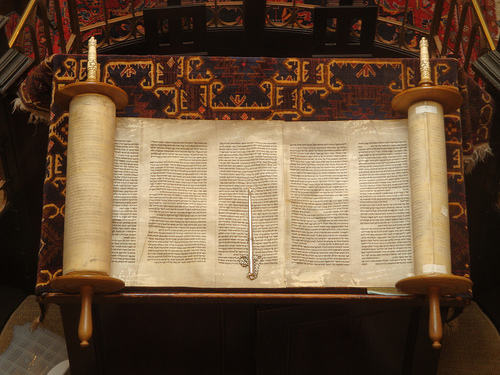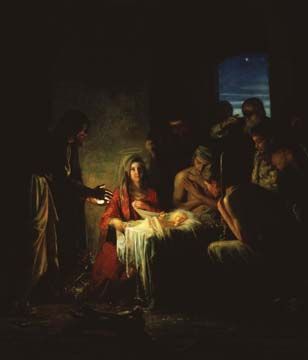Category: Scriptures
-
Grant Hardy’s Subject Problem
Criticisms of the Book of Mormon generally fall into one of two categories: objections to its historical claims on the one hand, and on the other critiques of its literary style. The two prongs are often combined in a single attack, for instance in the suggestion that the awkward style of the book reflects the…
-
Who Wrote the Gospels?
It always helps to know who wrote what you are reading, and Bible books are no exception. The four gospels, in particular, present interesting questions of how the narratives were composed and who did the composing.
-

Reading Scripture in the 21st Century
I recently read Thinking Through Our Faith: Theology for Twenty-first-Century Christians (Abingdon Press, 1998) by C. David Grant, a professor of religion at TCU. The book might be described as a short prologue to a 21st-century approach to theology, one that takes full account of science, historical criticism, and pluralism — in short, the sort…
-

Peace
Sometimes unintentional mistakes lead to interesting lines of thought. A few weeks ago I misheard a speaker in an LDS meeting. The speaker was quoting John 14:27, and either because of the speaker’s mispronunciation or my imperfect hearing, I heard the word “live” instead of the word “leave.” This lead me to think about what…
-
Notable Race-Related Changes to Footnotes and Chapter Headings in the Standard Works
Marvin Perkins is a Latter-day Saint music producer who is currently the Public Affairs Co-chair for the Genesis Group and who has worked to nurture understanding between African Americans and Latter-day Saints and attack misconceptions (see our 12 Questions series with Brother Perkins from 2009). This morning, Brother Perkins circulated the following email to his…
-

What we talk about when we talk about God
Bruce Feiler’s daughter was just five when she pitched him a question right to the gut of religious experience: “Daddy, if I speak to God, will he listen?” Feiler writes books on the Bible and God for a living, so he’d presumably given the question some thought. Nevertheless he had no good answer ready for…
-
Correlation is Killing Sunday School
Once upon a time, there was Sunday School, an independent auxiliary whose officers were appointed by senior LDS leaders and whose primary task was to develop a Sunday School curriculum, and commission and supervise the writing of lesson manuals. They did a nice job. Then came Correlation.
-
Myth and Ritual
Like some of you, I’ve been reading a book or two on the Old Testament, this year’s Sunday School course of study. Most recently I read Susan Niditch’s Ancient Israelite Religion (OUP, 1997), described in the jacket blurb as “a perceptive, accessible account of the religious beliefs and practices of the ancient Israelites.” Too often…
-

How to write a revelation
I have been working on a paper looking at the Doctrine and Covenants, and my research has me thinking about how the texts of modern revelation were produced. I think that there are a lot of Mormons who assume that the words of the revelations in the Doctrine and Covenants were dictated word for word…
-

An Unexpected Gift
At 3:28 this morning we welcomed a new son into the world. As one would expect, congratulations and well-wishes have come flooding in from friends and family all day. And for all of these we have been moved and grateful. First thing this morning, however, we received a congratulatory gift we hadn’t anticipated. Women housed…
-
Genesis and Genre
When we read Genesis, what exactly are we reading? The distinctions and categories we modern readers bring to books and narratives (fiction or nonfiction; science or folk tale; history or literature; poetry or prose; author’s original text or quoted source) may not serve us well when we read the Old Testament, a collection of ancient…
-

Reviving the Hebraic
Every four years we have a celebrated ritual during the second hour of church: it is the discussion by all members present on the topic of being uncomfortable studying the Old Testament.
-
Lucan Infancy Narrative
[Once again, these are just notes, and they do not even begin to do the subject justice, but yesterday’s Matthew notes were able to spark some good discussion. I will response and comment as I can today, but, hey, it is Christmas Eve Day!] While Matthew’s is largely from Joseph’s perspective, Luke’s from Mary’s This…
-
The Matthean Infancy Narrative
[Christmas realities have hit, making me admit that full length blogs the last two days of Christmas week are just not feasible! So forgive me as I just post here some “notes” on Matt and later Luke, consisting of largely recycled material from my class lectures!] Matthew’s is largely from Joseph’s perspective, Luke’s from Mary’s…
-

Studying the Infancy Narratives
This Christmas Eve, most of us will at least read the “Christmas Story,” as found in Luke 2:1-20. As we approach the holiday, a few more diligent souls will read all of the Infancy Narratives, as found in Matt 1-2 AND Luke 1-2. Yet even when reading (as opposed to just remembering or “thinking” about)…
-
Priesthood Session in a Nutshell
President Uchtdorf conducted the Priesthood session, featuring talks by Elder Ballard, Elder Gonzalez, Elder Choi, Elder Uchtdorf, Elder Eyring and President Monson. Direct quotations (based on my notes) are given in quotes; phrases without quotes are my summary of the remarks given.
-
Royal Skousen’s 12 questions — The Critical Text Version
Last month we posted Royal Skousen’s discussion of his work on recovering the earliest version of the Book of Mormon, along with some updates. Unfortunately, that post garnered some annoying formatting problems — mostly due to the new format T&S adopted this year. We’re happy to now present to you mark III of Royal Skousen’s…
-
Divine Comedy, Divine Tragedy
The Bible, as we have received it, sets out the drama of salvation with its wrenching fall and crucifixion, but joyous resurrection and exaltation. Though its compilation is in many ways ad hoc, there is a satisfyingly comedic structure to the whole. As Terryl Givens puts it in his The Book of Mormon: A Very…
-
Some Notes on the New Spanish LDS Bible
My copy of the new LDS edition of the Bible in Spanish arrived yesterday, one of the 750,000 copies printed recently (according to a contact I have in the Church department that prints these materials). So I thought I would pass on my impressions.
-
12 Questions and a Book by Royal Skousen
5 years ago we published one of my favorite “12 Questions” posts, in which Royal Skousen discussed in some depth what he has learned from his extensive work on the earliest editions of the Book of Mormon. His book, The Book of Mormon: The Earliest Text, is being published in September by Yale University Press…
-
12 Questions for Marvin Perkins, Part Four
Here is the last installment of our 12 Questions with Marvin Perkins, comprised of Brother Perkins’ responses to our last two questions. We’d like to thank Brother Perkins for the time and effort he’s put in to giving us a set of very substantive and thought-provoking responses.
-
12 Questions for Marvin Perkins, Part Three
Here is Part Three of our 12 Questions with Marvin Perkins, comprised of Brother Perkins’ responses to our next five questions. See Parts One, Two, and Four for our introduction of Brother Perkins and his responses to our other questions.
-
12 Questions for Marvin Perkins, Part Two
Here is Part Two of our 12 Questions with Marvin Perkins, comprised of Brother Perkins’ responses to our next four questions. See Parts One, Three and Four for our introduction of Brother Perkins and his responses to our other questions.
-
Thou-thee-thy from other angles
In General Conference of April 2009, Elder Russell M. Nelson reminded us:
-
DNA Delight
A recent DNA study has gotten some attention, both on our sidebar and in a post by J. Nelson-Seawright at By Common Consent. The Mormon question that inevitably comes up from such a study is does it cast any light on the question of whether Lehi really landed in the Americas long ago? J. Nelson-Seawright…
-
What Does My Lack of Personal Trials Say About Me?
I’ve been thinking long and hard about what I should talk about in my inaugural post on this blog. Quite honestly, when I agreed to do a stint as a guest blogger, I thought it would be pretty easy. But, lately, it seems that all my Mormonism-related thoughts have been trite and meaningless. For example,…
-
Breathing the Breath of God
Genesis (2:7) says that God breathed life into Adam’s nostrils. Is our life a portion of God’s? Jesus quoted a Psalm (82:6) that said, “Ye are gods,” when confronted about his claims to divinity. Mormons are usually not so bold, but there is certainly an element in our tradition that states that humans are children…
